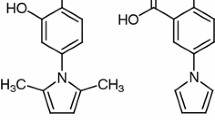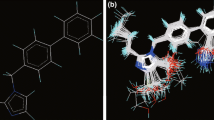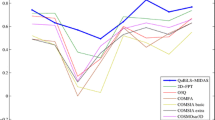Abstract
Quantitative relationships between molecular structures and CCR5 inhibitory activities of forty two 1-amino-2-phenyl-4-(piperidin-1-yl)-butane derivatives were discovered by chemometrics tools including GA-MLR and FA-MLR as linear models and GA-LS-SVM and FA-LS-SVM as nonlinear models. GA-MLR analysis indicated that the topological (X2A) and geometrical (MAXDN) parameters have the most significant influence on the CCR5 inhibitory activity. FA-MLR model describes the effect of topological, geometrical, and quantum indices on the CCR5 inhibitory activity of the studied molecules. A comparison between the developed statistical methods revealed that FA-LS-SVM represented superior results and it could predict about 95 % of variance in the inhibitory activity data. The resulted models were validated for generalization and predictability by leave-one-out (LOO) cross-validation method. External validation showed high predictability of the calibration models. The predictability of the obtained QSAR models was also investigated by the Tropsha and Roy proposed criteria. Further validation by Y-randomization method confirmed that the obtained models were not due to a chance correlation. The applicability domain of the models was defined by leverage value. None of the studied compounds were outside the domain of the models.





Similar content being viewed by others
References
Afantitis A, Melagraki G, Sarimveis H, Koutentis P, Markopoulos J, Igglessi-Markopoulou O (2006a) Investigation of substituent effect of 1-(3,3-diphenylpropyl)-piperidinyl phenylacetamides on CCR5 binding affinity using QSAR and virtual screening techniques. J Comput Aided Mol Des 20(2):83–95. doi:10.1007/s10822-006-9038-2
Afantitis A, Melagraki G, Sarimveis H, Koutentis PA, Markopoulos J, Igglessi-Markopoulou O (2006b) A novel QSAR model for predicting induction of apoptosis by 4-aryl-4H-chromenes. Bioorg Med Chem 14(19):6686–6694
Arfken GB, Weber HJ (1995) Mathematical methods for physicists, 4th edn. Academic Press, New York
Arkan E, Shahlaei M, Pourhossein A, Fakhri K, Fassihi A (2010) Validated QSAR analysis of some diaryl substituted pyrazoles as CCR2 inhibitors by various linear and nonlinear multivariate chemometrics methods. Eur J Med Chem 45(8):3394–3406. doi:10.1016/j.ejmech.2010.04.024
Baumann K (2003) Cross-validation as the objective function for variable-selection techniques. TrAC, Trends Anal Chem 22(6):395–406
Cho S, Hermsmeier M (2002) Genetic algorithm guided selection: variable selection and subset selection. J Chem Inf Comput Sci 42(4):927–936
Clapham P, McKnight A (2002) Cell surface receptors, virus entry and tropism of primate lentiviruses. J Gen Virol 83(Pt 8):1809–1829
Clavel F, Guyader M, Guetard D, Salle M, Montagnier L, Alizon M (1986) Molecular cloning and polymorphism of the human immune deficiency virus type 2. Nature 324(6098):691–695
Cocchi F, DeVico A, Garzino-Demo A, Arya S, Gallo R, Lusso P (1995) Identification of RANTES, MIP-1 alpha, and MIP-1 beta as the major HIV-suppressive factors produced by CD8+ T cells. Science 270(5243):1811–1815
Cristianini N, Shawe-Taylor J (2000) An introduction to support vector machines and other kernel-based learning methods. Cambridge University Press, Cambridge
Dessalew N (2008) QSAR study on piperidinecarboxamides as antiretroviral agents: an insight into the structural basis for HIV coreceptor antagonist activity. QSAR Comb Sci 27(7):901–912. doi:10.1002/qsar.200760177
Dorn CP, Finke PE, Oates B, Budhu RJ, Mills SG, MacCoss M, Malkowitz L, Springer MS, Daugherty BL, Gould SL, DeMartino JA, Siciliano SJ, Carella A, Carver G, Holmes K, Danzeisen R, Hazuda D, Kessler J, Lineberger J, Miller M, Schleif WA, Emini EA (2001) Antagonists of the human CCR5 receptor as anti-HIV-1 agents. Part 1: discovery and initial structure-activity relationships for 1-amino-2-phenyl-4-(piperidin-1-yl)butanes. Bioorg Med Chem Lett 11(2):259–264
Dorr P, Perros M (2008) CCR5 inhibitors in HIV-1 therapy. Expert Opin Drug Discov 3(11):1345–1361. doi:10.1517/17460440802487047
Dorr P, Westby M, Dobbs S, Griffin P, Irvine B, Macartney M, Mori J, Rickett G, Smith-Burchnell C, Napier C, Webster R, Armour D, Price D, Stammen B, Wood A, Perros M (2005) Maraviroc (UK-427,857), a potent, orally bioavailable, and selective small-molecule inhibitor of chemokine receptor CCR5 with broad-spectrum anti-human immunodeficiency virus type 1 activity. Antimicrob Agents Chemother 49(11):4721–4732
Duan M, Aquino C, Ferris R, Kazmierski WM, Kenakin T, Koble C, Wheelan P, Watson C, Youngman M (2009) [2-(4-Phenyl-4-piperidinyl)ethyl]amine based CCR5 antagonists: derivatizations at the N-terminal of the piperidine ring. Bioorg Med Chem Lett 19(6):1610–1613
Finke PE, Oates B, Mills SG, MacCoss M, Malkowitz L, Springer MS, Gould SL, DeMartino JA, Carella A, Carver G, Holmes K, Danzeisen R, Hazuda D, Kessler J, Lineberger J, Miller M, Schleif WA, Emini EA (2001) Antagonists of the human CCR5 receptor as anti-HIV-1 agents. Part 4: synthesis and structure-Activity relationships for 1-[N-(Methyl)-N-(phenylsulfonyl)amino]-2-(phenyl)-4-(4-(N-(alkyl)-N-(benzyloxycarbonyl)amino)piperidin-1-yl)butanes. Bioorg Med Chem Lett 11(18):2475–2479
Golbraikh A, Tropsha A (2002) Beware of q2! J Mol Graph Model 20(4):269–276
Gramatica P, Papa E (2003) QSAR modeling of bioconcentration factor by theoretical molecular descriptors. QSAR Comb Sci 22:374–385
Hale JJ, Budhu RJ, Holson EB, Finke PE, Oates B, Mills SG, MacCoss M, Gould SL, DeMartino JA, Springer MS, Siciliano S, Malkowitz L, Schleif WA, Hazuda D, Miller M, Kessler J, Danzeisen R, Holmes K, Lineberger J, Carella A, Carver G, Emini E (2001) 1(3), pp. 4-Trisubstituted pyrrolidine CCR5 receptor antagonists. Part 2: lead optimization affording selective, orally bioavailable compounds with potent Anti-HIV activity. Bioorg Med Chem Lett 11(20):2741–2745
Hazuda DJ, Felock P, Witmer M, Wolfe A, Stillmock K, Grobler JA, Espeseth A, Gabryelski L, Schleif W, Blau C, Miller MD (2000) Inhibitors of strand transfer that prevent integration and inhibit HIV-1 replication in cells. Science 287(5453):646–650
Hoxie J, LaBranche C, Endres M, Turner J, Berson J, Doms R, Matthews T (1998) CD4-independent utilization of the CXCR4 chemokine receptor by HIV-1 and HIV-2. J Reprod Immunol 41(1–2):197–211
Kennard R, Stone L (1969) Computer aided design of experiments. Technometrics 11(1):137–148
Kier LB (1989) An index of molecular flexibility from kappa shape attributes. Quant Struct-Act Relat 8(3):221–224. doi:10.1002/qsar.19890080307
Kier LB, Hall LH, Frazer JW (1991) An index of electrotopological state for atoms in molecules. J Math Chem 7(1):229–241. doi:10.1007/bf01200825
Lu S-F, Chen B, Davey D, Dunning L, Jaroch S, May K, Onuffer J, Phillips G, Subramanyam B, Tseng J-L, Wei RG, Wei M, Ye B (2007) CCR5 receptor antagonists: discovery and SAR of novel 4-hydroxypiperidine derivatives. Bioorg Med Chem Lett 17(7):1883–1887
Lynch CL, Gentry AL, Hale JJ, Mills SG, MacCoss M, Malkowitz L, Springer MS, Gould SL, DeMartino JA, Siciliano SJ, Cascieri MA, Doss G, Carella A, Carver G, Holmes K, Schleif WA, Danzeisen R, Hazuda D, Kessler J, Lineberger J, Miller M, Emini EA (2002) CCR5 antagonists: bicyclic isoxazolidines as conformationally constrained N-1-substituted pyrrolidines. Bioorg Med Chem Lett 12(4):677–679
Roy PP, Roy K (2008) On some aspects of variable selection for partial least squares regression models. QSAR Comb Sci 27(3):302–313
Saghaie L, Shahlaei M, Madadkar-Sobhani A, Fassihi A (2010) Application of partial least squares and radial basis function neural networks in multivariate imaging analysis-quantitative structure activity relationship: study of cyclin dependent kinase 4 inhibitors. J Mol Graph Model 29:518–528
Saghaie L, Shahlaei M, Fassihi A, Madadkar-Sobhani A, Gholivand M, Pourhossein A (2011) QSAR analysis for some diaryl-substituted pyrazoles as CCR2 inhibitors by GA-stepwise MLR. Chem Biol Drug Des 77(1):75–85
Samson M, Libert F, Doranz BJ, Rucker J, Liesnard C, Farber C-M, Saragosti S, Lapoumeroulie C, Cognaux J, Forceille C, Muyldermans G, Verhofstede C, Burtonboy G, Georges M, Imai T, Rana S, Yi Y, Smyth RJ, Collman RG, Doms RW, Vassart G, Parmentier M (1996) Resistance to HIV-1 infection in Caucasian individuals bearing mutant alleles of the CCR-5 chemokine receptor gene. Nature 382(6593):722–725
Shahlaei M, Fassihi A, Nezami A (2009) QSAR Study of some 5-methyl/trifluoromethoxy-1H-indole-2,3-dione-3-thiosemicarbazone derivatives as anti-tubercular agents. Res Pharm Sci 4(2):123–131
Shahlaei M, Fassihi A, Saghaie L (2010a) Application of PC-ANN and PC-LS-SVM in QSAR of CCR1 antagonist compounds: a comparative study. Eur J Med Chem 45(4):1572–1582
Shahlaei M, Sabet R, Ziari MB, Moeinifard B, Fassihi A, Karbakhsh R (2010b) QSAR study of anthranilic acid sulfonamides as inhibitors of methionine aminopeptidase-2 using LS-SVM and GRNN based on principal components. Eur J Med Chem 45(10):4499–4508. doi:10.1016/j.ejmech.2010.07.010
Shen D-M, Shu M, Willoughby CA, Shah S, Lynch CL, Hale JJ, Mills SG, Chapman KT, Malkowitz L, Springer MS, Gould SL, DeMartino JA, Siciliano SJ, Lyons K, Pivnichny JV, Kwei GY, Carella A, Carver G, Holmes K, Schleif WA, Danzeisen R, Hazuda D, Kessler J, Lineberger J, Miller MD, Emini EA (2004) Antagonists of human CCR5 receptor containing 4-(pyrazolyl)piperidine side chains. Part 2: discovery of potent, selective, and orally bioavailable compounds. Bioorg Med Chem Lett 14(4):941–945
Suykens JAK, Vandewalle J (1999) Least squares support vector machine classifiers. Neural Process Lett 9(3):293–300
Suykens AK, van Gestel T, de Brabanter J, de Moor B, Vandewalle J (2002) Least-squares support vector machines. World Scientifics, Singapore
Todeschini R, Consonni V (2000) Handbook of molecular descriptors. Wiley-VCH, Weinheim
Todeschini R, Consonni V, Mauri A, Pavan M (2002) DRAGON software 2.1 edn. Milano, Italy
Tropsha A, Gramatica P, Gombar V (2003) The importance of being earnest: validation is the absolute essential for successful application and interpretation of QSPR models. QSAR Comb Sci 22(1):69–77
Vapnik VN (1995) The nature of statistical learning theory. Springer, New York
Viola A, Luster AD (2008) Chemokines and their receptors: drug targets in immunity and inflammation. Annu Rev Pharmacol Toxicol 48(1):171–197. doi:10.1146/annurev.pharmtox.48.121806.154841
Wan J, Zhang L, Yang G, Zhan C (2004) Quantitative structure-activity relationship for cyclic imide derivatives of protoporphyrinogen oxidase inhibitors: a study of quantum chemical descriptors from density functional theory. J Chem Inf Comput Sci 44(6):2099–2105
Wei RG, Arnaiz DO, Chou Y-L, Davey D, Dunning L, Lee W, Lu S-F, Onuffer J, Ye B, Phillips G (2007) CCR5 receptor antagonists: discovery and SAR study of guanylhydrazone derivatives. Bioorg Med Chem Lett 17(1):231–234
Willoughby CA, Rosauer KG, Hale JJ, Budhu RJ, Mills SG, Chapman KT, MacCoss M, Malkowitz L, Springer MS, Gould SL, DeMartino JA, Siciliano SJ, Cascieri MA, Carella A, Carver G, Holmes K, Schleif WA, Danzeisen R, Hazuda D, Kessler J, Lineberger J, Miller M, Emini EA (2003) 1(3), pp. 4 trisubstituted pyrrolidine CCR5 receptor antagonists bearing 4-aminoheterocycle substituted piperidine side chains. Bioorg Med Chem Lett 13(3):427–431
Xu Y, Liu H, Niu C, Luo C, Luo X, Shen J, Chen K, Jiang H (2004) Molecular docking and 3{D} QSAR studies on 1-amino-2-phenyl-4-(piperidin-1-yl)-butanes based on the structural modeling of human {CCR}5 receptor. Bioorg Med Chem 12(23):6193–6208
Yuan Y, Zhang R, Hu R, Ruan X (2009) Prediction of CCR5 receptor binding affinity of substituted 1-(3,3-diphenylpropyl)-piperidinyl amides and ureas based on the heuristic method, support vector machine and projection pursuit regression. Eur J Med Chem 44(1):25–34
Zhuo Y, Kong R, Cong XJ, Chen WZ, Wang CX (2008) Three-dimensional QSAR analyses of 1,3,4-trisubstituted pyrrolidine-based CCR5 receptor inhibitors. Eur J Med Chem 43(12):2724–2734
Author information
Authors and Affiliations
Corresponding author
Rights and permissions
About this article
Cite this article
Shahlaie, M., Fassihi, A., Pourhossein, A. et al. Statistically validated QSAR study of some antagonists of the human CCR5 receptor using least square support vector machine based on the genetic algorithm and factor analysis. Med Chem Res 22, 1399–1414 (2013). https://doi.org/10.1007/s00044-012-0138-3
Received:
Accepted:
Published:
Issue Date:
DOI: https://doi.org/10.1007/s00044-012-0138-3




